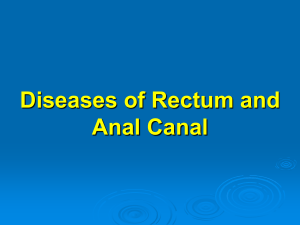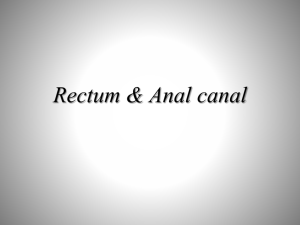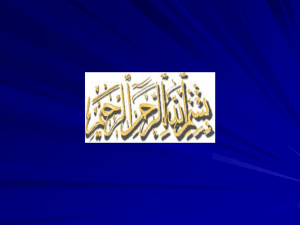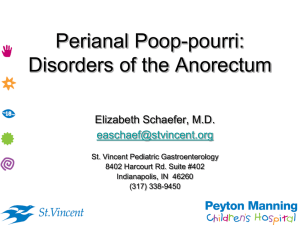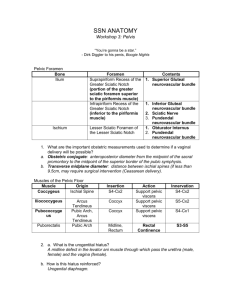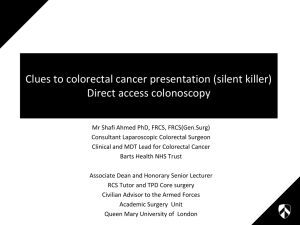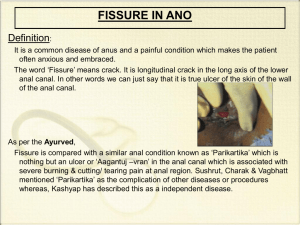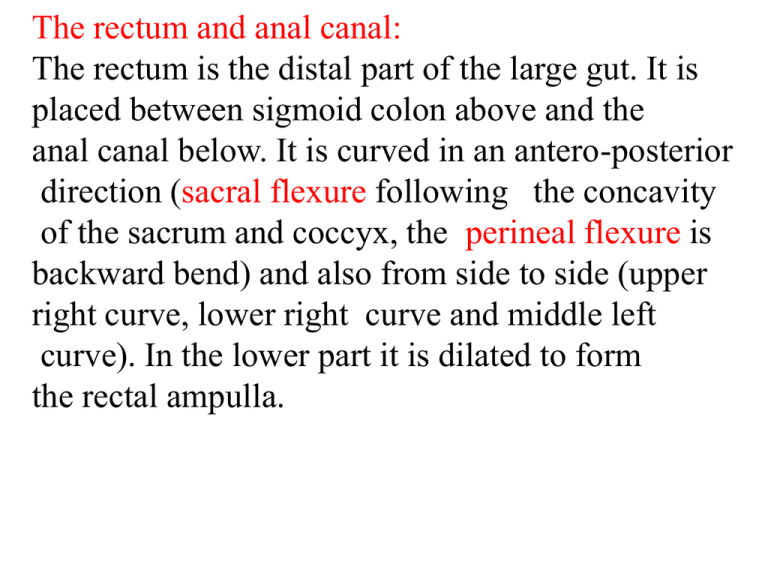
The rectum and anal canal:
The rectum is the distal part of the large gut. It is
placed between sigmoid colon above and the
anal canal below. It is curved in an antero-posterior
direction (sacral flexure following the concavity
of the sacrum and coccyx, the perineal flexure is
backward bend) and also from side to side (upper
right curve, lower right curve and middle left
curve). In the lower part it is dilated to form
the rectal ampulla.
Sacral
flexure
Perineal flexure
Visceral relations:
Anteriorly in males:rectovesical pouch, urinary
bladder, the terminal part of the ureters, seminal
vesicles, deferent ducts and prostate. Anteriorly
in female: rectouterine pouch, uterus and vagina.
Posteriorly: sacrum,coccyx and anococcygeal
ligament, piriformis, coccygeus and levator ani,
median sacral ,superior rectal & lower lateral
sacral vessels, sympathetic chain with the ganglion
impar, anterior primary rami of S3-5 ,Cox1,pelvic
splanchnic nerve.
Sacral
flexure
Perineal flexure
anterior
left
Right
posterior
Mucosal folds: the transverse or horizontal folds or
Houston’valve: upper fold projects from right,
middle fold projects from anterior and right wall,
lowest fold projects from left wall.
Arterial supply and
venous drainage:
1.superior rectal artery, this is the chief artery
and comes from inferior mesenteric artery
2.middle rectal artery which comes from internal
iliac artery.
3.median sacral artery, it arises from aorta.
Superior rectal vein drains into inferior mesenteric
vein, middle rectal vein drain into internal iliac vein.
Supports of rectum:
1.pelvic floor formed by levator ani
2.fascia of Waldeyer, it attaches rectal ampulla to the
sacrum.
3.lateral ligaments of the rectum
4.rectovesical fascia of Denovilliers, it extends
from rectum to seminal vesicles and prostate
5.pelvic peritoneum
6.perineal body with its muscles
The anal canal is the terminal part of the large
intestine. It is situated below the level of the
pelvic diaphragm and lies in anal triangle of perineum.
The anal canal is 3.8cm long, it extends from
the anorectal junction to the anus.The anorectal junction
Is marked by the forward convexity of the perineal
flexure of the rectum, the anus is the surface opening
of the anal canal, situated about 4cm below and in
front of the tip of the coccyx in the cleft between two
buttocks. Anteriorly it is related to perineal body,
membranous urethra, bulb of penis,
lower end of the vagina, posteriorly,anococcygeal
ligament, tip of the coccyx, laterally, ischiorectal fossae.
Sacral
flexure
Perineal flexure
Interior of the anal canal shows many features and
can be divided into three parts :upper part is lined by
mucous membrane, & is of endodermal origin.
The mucous membrane shows 6 to 10 vertical folds,
these folds are called the anal columns of Morgagni.
The lower ends of the anal columns are united to
Each other by short semilunar folds of mucous
membrane, these folds are called the anal valves. Above
each valve there is a depression in the mucosa which
is called the anal sinus, the anal valves together form
a transverse line that runs all round the anal canal .this
is pectinate line.
Anal column
Anal sinus(crypt)
Anal valve
The middle part of anal canal is termed as
transitional zone or pecten, it is also lined by
mucous membrane. The mucosa has a bluish
appearance because of a dense venous plexus
that lies beneath. The lower limit of the pecten often
has a whitish appearance because of which it is
referred to as the white line or Hilton’s line,
is situated at the level the interval between the
subcutaneous part of external anal sphincter and
the lower border of internal anal sphincter.
Lower cutaneous part is about 8mm long and is lined
by true skin containing sweat and sebaceous glands.
Musculature of the anal canal:
1.internal anal sphincter is involuntary in nature,
It is formed by the thickened circular muscle coat
of this part of the gut.
2.the external anal sphincter is under voluntary control.
& has three parts: subcutaneous ,superficial and deep
parts.
subcutaneous part lies below the level of internal
sphincter and surrounds the lower part of the anal canal.
The superficial part is elliptical in shape and arises from
the terminal segment of the coccyx and anococcygeal
ligament, the fibres surround the lower part of the
internal sphincter and are inserted into the perineal body.
The deep part surrounds the upper part of the internal
sphincter and is fused with the puborectalis.
Anorectal ring:this is a muscular ring present
at the anorectal junction. It is formed by
the fusion of the puborectalis, deep external
sphincter and the internal sphincter, which
can be felt on rectal examination .Surgical
division of this ring results in rectal incontinence.
Arterial supply:the part of the anal canal above the
Pectinate line is supplied by the superior rectal artery,
the part below the pectinate line is supplied by the
inferior rectal artery.
Venous drainage: internal rectal venous plexus drains
into superior rectal vein, the lower part of
the external rectal venous plexus is drained
by inferior rectal vein into the internal pudendal
vein, the middle part by the middle rectal vein
into the internal iliac vein & upper part by
the superior rectal vein into the inferior mesenteric
vein. The anal vein are arranged radially around the
anal margin. They communicate with the internal
rectal plexus and with the inferior rectal vein.
Lymphatic drainage and nerve supply:
1.lymph vessels from the part above the pectinate
line drain into the internal iliac nodes. Vessels from
the part below the pectinate line drain into superficial
inguinal nodes.
2.nerve supply: above the pectinate line, the anal canal
is supplied by autonomic nerves (inferior hypogastric
plexus and pelvic splanchnic). Below the pectinate line
it is supplied by somatic (inferior rectal )nerves.
The external sphincter is supplied by inferior rectal
Nerve and by branch of the fourth sacral nerve.


